Which Artist's Work Includes Plump And Bloated People And Animals As A Signature Feature
7 important things to know nearly artist signatures
Holly Black consults Christie'south specialists, a conservator, a gallerist and an expert cataloguer on the truths an artist's mark can reveal, the insights they offer into process and why — sometimes — a faux signature can muffle noble intentions
- 1
Artist signatures showtime became prevalent during the early Renaissance, which saw art production shift from co-operative guild systems to a celebration of individual creativity. A signature was the perfect way to differentiate your talent from that of lesser peers.
In the instance of Albrecht Dürer, whose famed monogram featured prominently on everything from printed masterpieces to hurried sketches, his 'AD' trademark (to a higher place) was so popular that he went to court in both Nuremberg and Venice in a successful bid to protect his authorship, resulting in the subsequent proliferation of copycat prints labelled 'after Dürer'.
- 2
'I've worked with artists who employ signatures as a annotation to themselves,' says Sid Motion, who works with emerging gimmicky artists at her eponymous gallery. 'It's a way of saying, "That slice is complete, don't rework it". It's an honest, personal marker that stops them incessantly returning to a piece.'
Signatures are besides ordinarily used to go on a record of fourth dimension, place and medium, as much as they are a signifier of a completed piece of work. 'Ben Nicholson recorded a wealth of information on the back of his boards,' says Rachel Hidderley, Christie's Senior Director of Modern British and Irish Art. 'He non only signed, titled and dated his piece of work, only sometimes even listed the colours he used, or the address of where he would be sending the work on to.'
- 3
'In that location's no end to the variety of signatures an private might use,' according to John Castagno, an artist and renowned expert who has produced 17 reference books cataloguing artist signatures throughout history, too every bit offering a full consultation service to museums, galleries and collectors.
'My offset book independent more than 10,000 entries,' he explains, 'with many artists using symbols and variations on their name. James McNeill Whistler had many different styles [he was well known for his apply of a butterfly motif not only in his art, simply also in his personal correspondence]. In other cases marks are nigh completely illegible, such as those of Jean-Michel Basquiat. He had two script signatures that were virtually impossible to read, along with his printed version.'
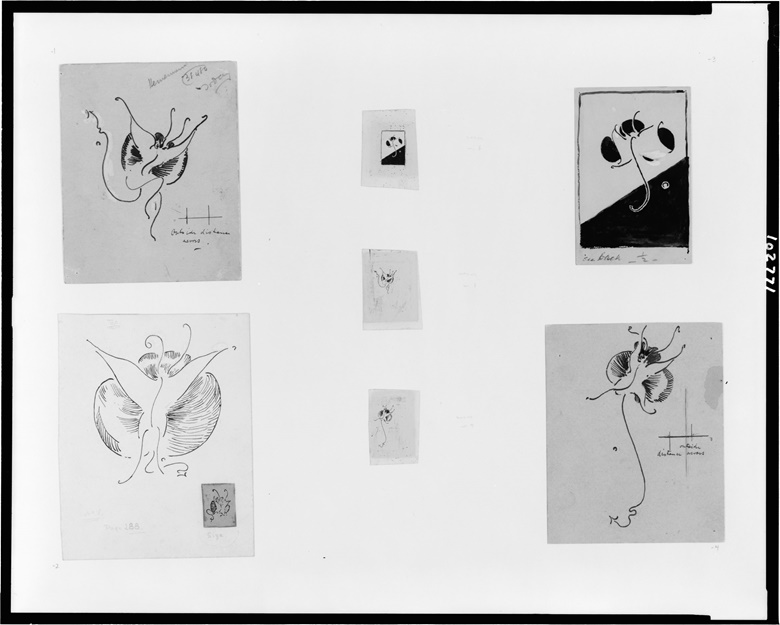
James McNeill Whistler (1834-1903), Butterfly designs, 1890-99. Seven drawings, pen and ink, white paint, and graphite, with four photomechanical print reproductions
Although these variations might seem disruptive, they can actually be very useful when it comes to dating a work. 'Picasso is a corking case,' says Christie's Impressionist and Modern Art specialist Allegra Bettini. 'In his early career he signed including his eye name equally P R (or Ruiz) Picasso, later dropping the initial and developing a more decorative version.
'During his analytical Cubist menstruation he stopped signing the fronts of his canvases entirely in order not to backbite from the art itself, whereas later on on he adopted his famous signature, consummate with an underlining dash. This was also used as a symbol of completion.'
- 4
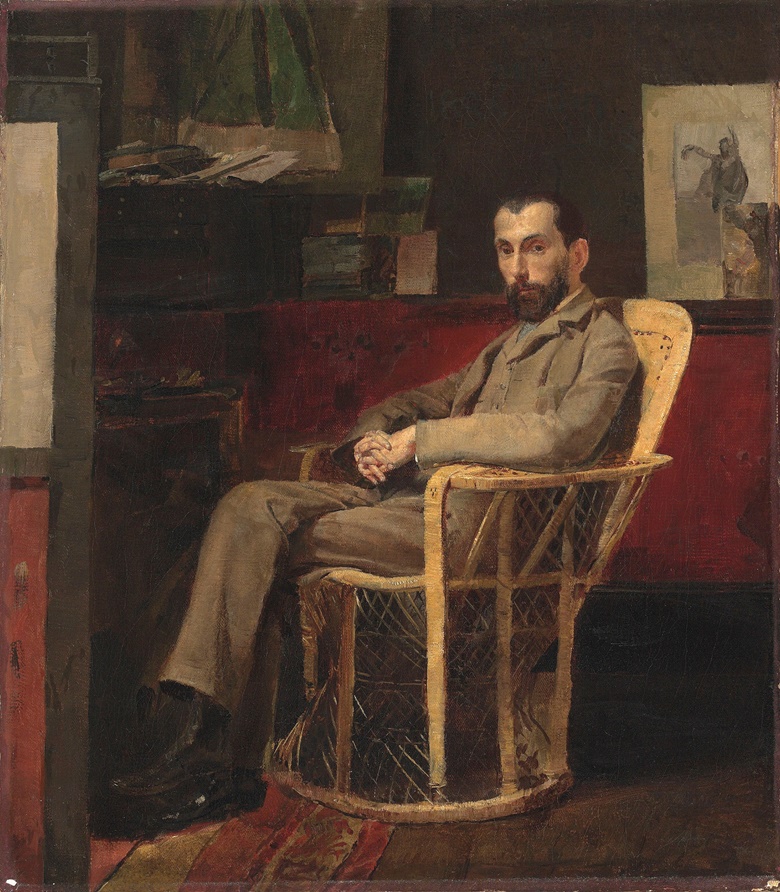
Thomas (Tom) William Roberts (1856-1931), Portrait of Louis Abrahams. Indistinctly signed, defended and dated 'Tom Roberts / for / friend / Don Luis / 1886' (to a higher place the sitter's head). Oil on canvas. 16 x xiv in (forty.half dozen x 35.6 cm). Sold for £314,500 on 24 September 2015 at Christie'due south in London
Uncovering hidden signatures can reveal a wealth of information lost during the passage of time. In 2015, Christie'southward Australian Art department discovered a hidden signature and inscription past the Australian Impressionist Tom Roberts.
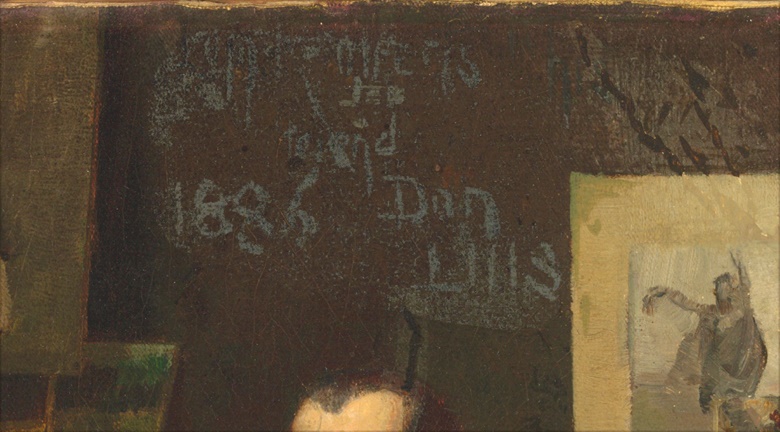
Detail showing the signature, from Thomas (Tom) William Roberts (1856-1931), Portrait of Louis Abrahams. Indistinctly signed, dedicated and dated 'Tom Roberts / for / friend / Don Luis / 1886' (above the sitter'due south head). Oil on canvas. 16 x 14 in (40.6 x 35.6 cm). Sold for £314,500 on 24 September 2015 at Christie'due south in London
'When studying the portrait of Louis Abraham in that location was no visible signature,' recalls Head of Sale Amanda Fuller. 'But as we moved the work around under the light, something caught our eye. Nosotros had the work photographed and asked our digital studio to enhance the image, and in doing so they were able to reveal a dedication from the artist to the sitter, signed and dated, in the groundwork. It was a great moment, equally this confirmed our suspicion that the piece of work was indeed painted by Tom Roberts.'
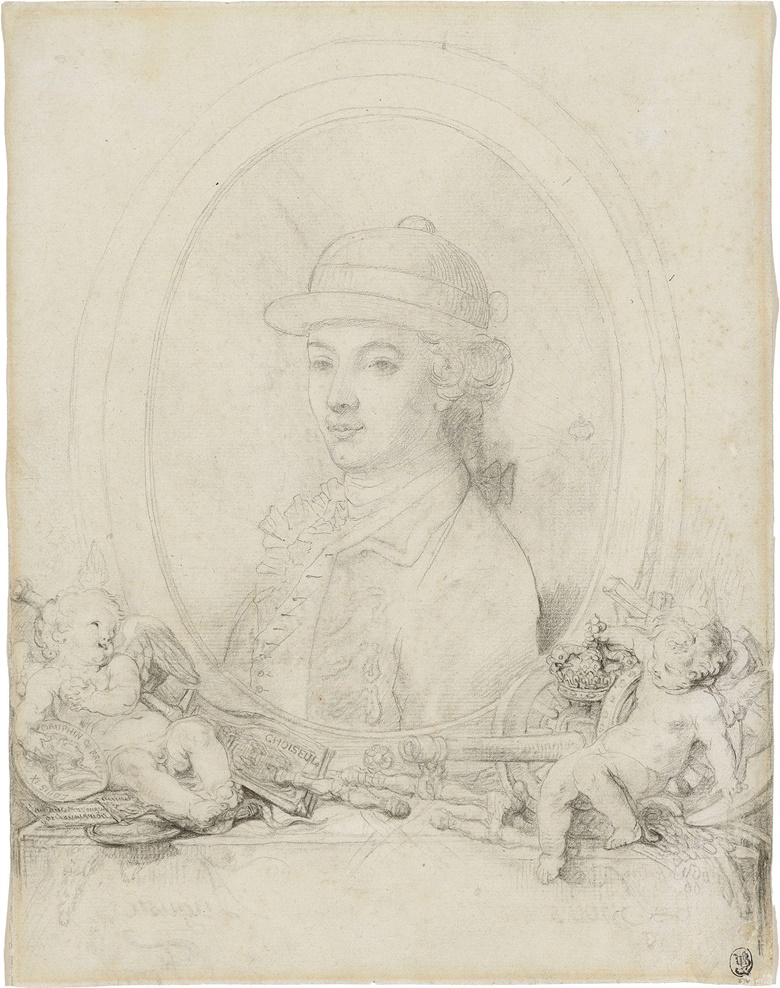
Gabriel-Jacques de Saint-Aubin, Portrait of King Louis Xvi equally Dauphin. Inscribed 'Louis 9 Dauphin de France / au duc de La Vauguyon / CHOISEUL' and indistinctly inscribed at the ledge 'Louis Auguste' (in reverse). Black chalk and pencil, watermark crowned fleur-de-lys with a countermark M. 10⅞ x viii½ in (27.seven ten 21.half-dozen cm). Sold for £8,225 in The Dr Anton C.R. Dreesmann Collection Old Primary Pictures in 2002 at Christie'southward in London
An even more unusual instance is that of a cartoon past Gabriel-Jacques de Saint-Aubin, whose portrait of King Louis 16 was mistakenly considered to describe a woman, until almost 2002. 'Funnily plenty, when I was cataloguing this work a few weeks ago I actually realised that "Louis Auguste" was written in reverse at the ledge,' says Acquaintance Specialist Jonathan den Otter. 'Information technology looks as though no one had noticed this in the past 250 years! Information technology's written in the creative person'south typical handwriting, so it proves both the attribution and the identity of the sitter.'
- v
Although signatures tin confirm well-founded research, they can also be misleading. An upcoming lot in The Sometime Kamerbeek Collection sale briefly featured a spurious autograph past Bernardus Johannes Blommers, hiding the truthful identity of its creator, the Dutch painter Jozef Israëls.
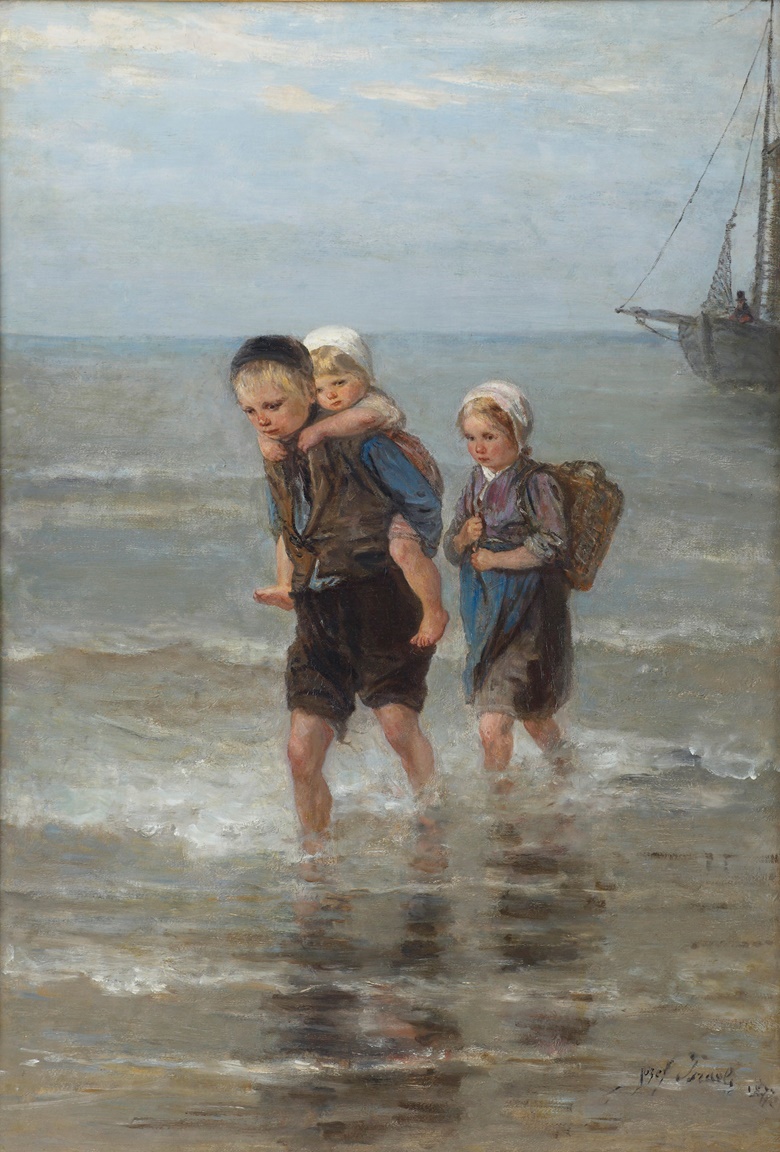
Jozef Israëls (1824-1911), Children in the Breakers, 1877. Signed and dated 'Jozef Israels 1877' (lower right). Oil on sail. 77.5 x 53.5 cm. Sold for €31,250 in The Former Kamerbeek Collection on 12 June 2017 at Christie'due south in Amsterdam
The painting was probably doctored during the 2nd World War in order to obscure the fact that the artist was Jewish, and to save his piece of work from being confiscated or destroyed. Subsequently its provenance was questioned in 2003 the real signature was uncovered in the lesser correct-mitt side of the piece, and the false version was removed.
- half-dozen
'Added signatures are a key event on the market place,' says Tom Rooth, Manager of the Victorian & British Impressionist Pictures Section at Christie'southward. 'They tend to fall into one of two camps. Either a painting has been created to imitate an artist's work, together with a mimicked signature, or someone might add a signature to a picture show at a afterwards date, in order to deceive, and increase value — sometimes significantly.
'Information technology is generally fairly easy to observe both,' Rooth explains. 'At that place is often a concentration in execution, and a slower, more than deliberate manner is credible that you wouldn't expect from someone signing their own proper noun; faked signatures often lack fluidity. Subsequently seeing numerous works signed by an artist, you also develop a familiarity with how they sign and inscribe. Of course you lot can as well put the painting under a UV calorie-free. If the signature has been added at a afterward date, the deviation in pigment volition show up past flaring.'
Rooth also looks out for artists who might have minimal signatures. 'Myles Birket Foster was an exceptional watercolourist, but his monogram was very simple. This has made him attractive to forgers who call back they tin replicate the simple 'BF' — although imitating the exceptional hand and brushstrokes of a maestro is significantly harder to get abroad with, to say the least.'
- vii
When because whether to invest in a piece of work of art it is important to know whether an creative person normally autographs their work. 'If you have the choice information technology is always wise to favour signed over unsigned examples,' advises Rachel Hidderley. 'However information technology is crucial to think that some artists — such every bit Stanley Spencer or Christopher Wood — never signed anything. So information technology pays to remember that sometimes you won't find a signature at all, and nor would you want to.'
In enquiry terms a signature is ever i piece in a larger puzzle. 'When we get-go run into a work of art, of class the inscription is something nosotros will take into consideration,' says Angelica Pediconi, a fine art conservator and fine art historian who has worked with international dealers, collectors and institutions including the National Gallery. 'Often something might be obscured due to oxidation, so if we uncover anything we are careful to examine it under a microscope.
'Y'all have to expect at the craquelure [the network of cracks that develops as paint layers age and shrink] to meet if it matches the panel or sail,' she continues, 'or piece of work out whether information technology has been retouched. When we make a discovery we are careful to transcribe our findings and consult with the possessor. Even so, signatures are just one office of what nosotros expect for in our research. Everything you need is in the painting itself — yous just demand the eye.'
Source: https://www.christies.com/Features/7-things-to-know-about-artist-signatures-8365-1.aspx
Posted by: wallaceborceir.blogspot.com

0 Response to "Which Artist's Work Includes Plump And Bloated People And Animals As A Signature Feature"
Post a Comment